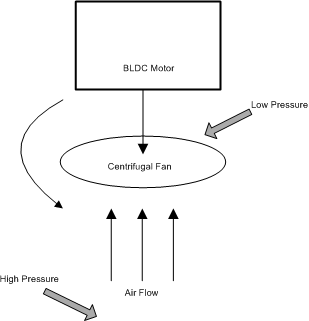SLVA654B June 2014 – March 2019 DRV8301 , DRV8301-Q1 , DRV8302 , DRV8303 , DRV8307 , DRV8308 , DRV8312 , DRV8323R , DRV8332
-
Hardware design considerations for an efficient vacuum cleaner using a BLDC motor
- Trademarks
- 1 Suction Principle
- 2 Brushless DC Motors (BLDC)
- 3 Microcontrollers
- 4 Gate Driver and MOSFETs
- 5 Isolation
- 6 Power Management (6 to 60-V DC Power Supply)
- 7 CAP and QEP interfaces
- 8 Enhanced Controller Area Network (eCAN)
- 9 High-Resolution and Synchronized ADCs
- 10 DRV8323R
- 11 Feedback Stage
- 12 Conclusion
- 13 About the Author
- 14 References
- Revision History
1 Suction Principle
A motor is attached to a centrifugal fan with angled blades. As the fan blades turn, they force air forward toward the exhaust port. When air particles are driven forward, the density of particles (and therefore the air pressure) increases in front of the fan and decreases behind the fan. The pressure level in the area behind the fan drops below the pressure level outside the vacuum cleaner (the ambient air pressure). This creates suction, which is a partial vacuum, inside the vacuum cleaner. The ambient air pushes into the vacuum cleaner through the intake port because the air pressure inside the vacuum cleaner is lower than the pressure outside. As long as the fan is running and the passageway through the vacuum cleaner remains open, there is a constant stream of air moving through the intake port and out of the exhaust port.
 Figure 1. Suction Principle
Figure 1. Suction Principle The suction motor load consideration is interesting. One or more fans are attached to the motor shaft and are rotated at a very high speed. The air entering the fan near the hub is forced to spin with the fan as the air passes through the fan. The load to the motor is the force required to overcome the inertia of the air as it enters the fan and is spun. When the air flow through the motor is reduced by increasing the resistance to the air flow, the load on the motor is actually reduced and the speed tends to fall. Therefore to increase the suction the current drawn from the mains increases, and hence the motor speed increases. The effect of this is to increase the suction created by the motor which helps to counteract the effect of the resistance to the air flow. Restricting the air flow completely creates the maximum possible suction. This maximum suction occurs when a sealed suction gauge is used. In essence, the maximum suction is greater than the suction which is produced in the normal operating range of the motor. Air watts is an effort to rate the output power of the vacuum cleaner instead of the input power drawn from the power source. ASTM International defines the air watt as shown in Equation 1.